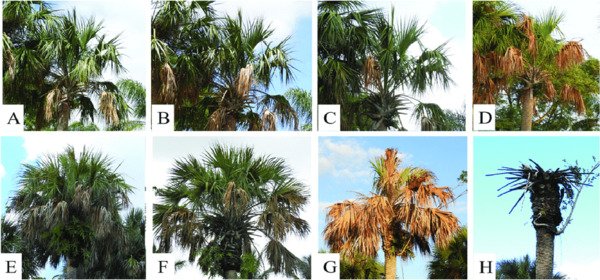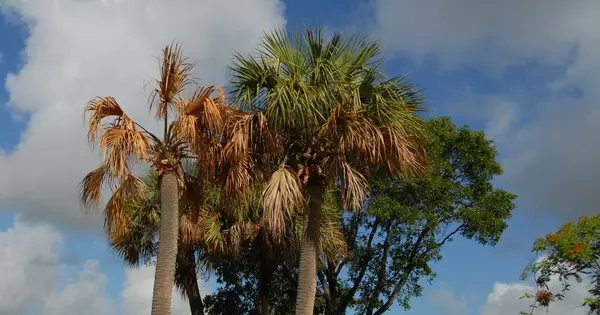The deadly bronzing disease, also known as Texas Phoenix palm decline (TPPD), is a devastating condition that affects a variety of palm tree species. It causes infected palms to decline and die in a relatively short period of time. Understanding this disease better is critical for creating effective management strategies and preserving palm tree populations.
A key chemical associated with lethal bronzing (LB) infected palm trees has been identified by scientists. LB is a bacterial disease that kills more than 20 species of palm trees in the Southern United States and the Caribbean, wreaking havoc on Florida’s green industries for nearly two decades.
Palm trees infected with the lethal bronzing disease emit signals that alert nearby healthy palm trees to the danger. Those healthy palms produce their own defense, which University of Florida scientists hope to harness one day to protect palms from disease.
Entomologist Brian Bahder and his colleagues at the UF/IFAS Fort Lauderdale Research and Education Center (UF/IFAS FLREC) see the study’s findings as a watershed moment in palm disease research because they hold great promise for developing management strategies for lethal bronzing, a deadly disease spread by a small insect known as a planthopper. This discovery could aid in the management of other palm and plant diseases.
The threatened palms produced a compound with known antimicrobial properties, and we are now interested in how this affects the epidemiology of lethal bronzing in the field. We hope to be able to harness these natural plant volatiles to either treat palms directly or stimulate them to produce their own defenses.
Brian Bahder
Plants that are stressed by disease or pests may emit small chemical signals or volatile organic compounds. These compounds warn healthy plants nearby. Those healthy plants can activate defense mechanisms – their own organic compounds – to potentially repel the pest responsible for the disease.
“Volatile organic compounds are common in plants and play an important role in plant protection,” Bahder explained. “Most importantly, some of these compounds exhibit antimicrobial activity.” They have the potential to be used in the defense of palms and possibly other plants against a variety of infections.”
“We suspected there was a chemical compound that the planthopper was detecting,” Bahder explained. “Our goal was to identify the chemical and see if it could be used as a bait system.” The resulting data revealed a much more interesting story, which could lay the groundwork for developing a management plan for lethal bronzing and possibly other palm diseases.”
This is the first time green leaf volatiles have been found in palms infected with the bacteria that causes lethal bronzing.

Bahder and his colleagues collected leaf samples from infected cabbage palms, threatened palm trees nearby, and healthy palm trees outside of the disease’s spread area for the study. All of the samples were collected from trees in Fort Lauderdale. They tested the plants for the disease among the three sets of palms and locations over time.
The bronzing-infected palms emitted a specific signal, whereas the healthy palms nearby responded and emitted a different signal. Healthy palms located away from the infected area emitted a different signal than infected and threatened palms.
“The threatened palms produced a compound with known antimicrobial properties, and we are now interested in how this affects the epidemiology of lethal bronzing in the field,” said Bahder. “We hope to be able to harness these natural plant volatiles to either treat palms directly or stimulate them to produce their own defenses.”
Lethal bronzing, first detected in Tampa in 2006, transmitted by the planthopper Haplaxius crudus was confirmed as the vector in 2021. For almost two decades, the disease has been making its way steadily across the state, creating significant casualties in Florida palms.
“The most important thing to note is that once symptoms show up on the palm tree, it is too late, which is why prevention has been the first line of defense,” said Bahder.
Currently, the only way to treat an infected tree is to cut it down. The surrounding trees must be sampled for phytoplasma to prevent the bacteria from spreading. If the palm test is negative, an antibiotic treatment with oxytetracycline is given as a preventative measure. The expensive treatment is repeated on a quarterly basis.
Scientists see the discovery of these plant-produced compounds as a breakthrough in developing ways to manage the disease, as it could allow for harnessing the plant’s own natural defenses to create a cure for infected plants, eliminating the need for expensive antibiotic treatments.
“Scientists hope to be able to harness these compounds in order to develop new management strategies,” Bader explained.
The next stage of the research process will require additional funding to find ways to treat infected palms using the healthy green leaf volatiles compounds that are natural to the palm’s defense system. Methods could include injecting the compound directly into infected palms, which would hopefully cure the infection. It could also entail placing dispensers or spraying risk areas to stimulate the at-risk palms’ natural defenses.





